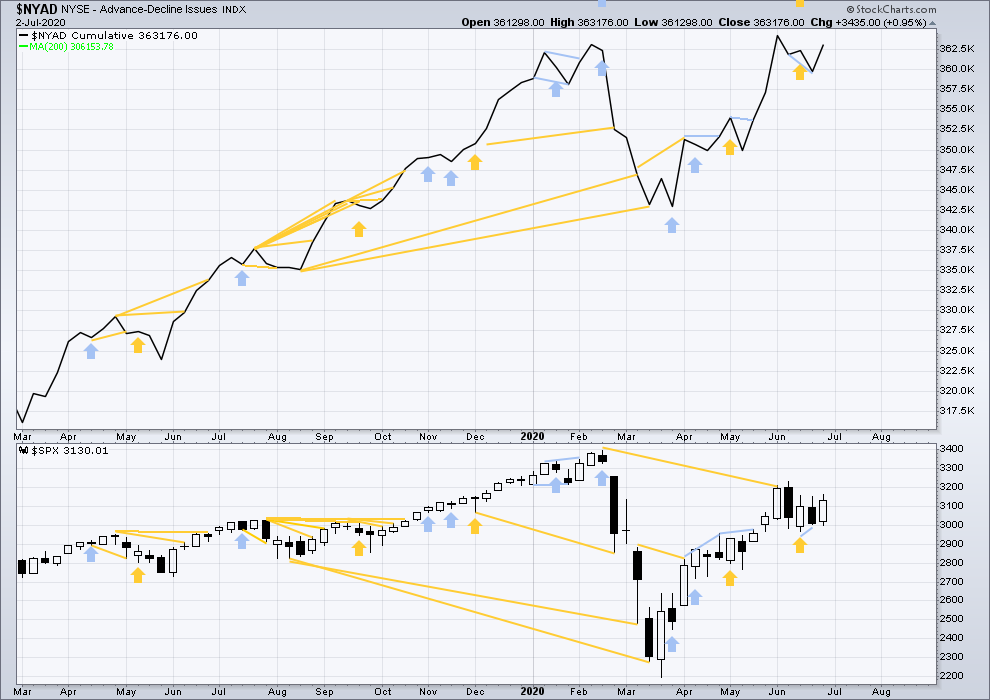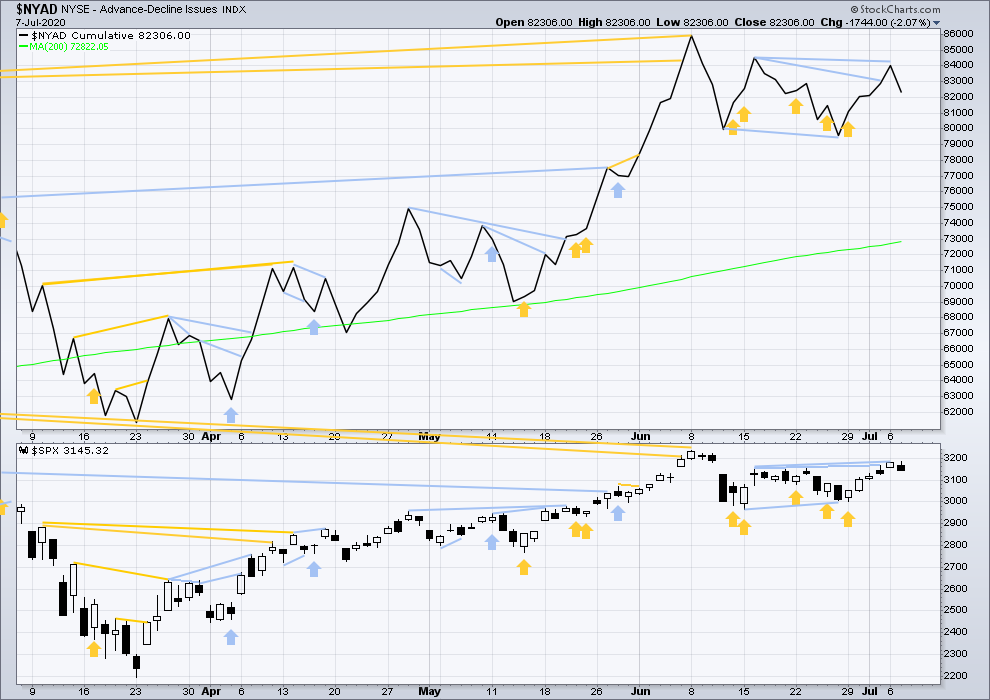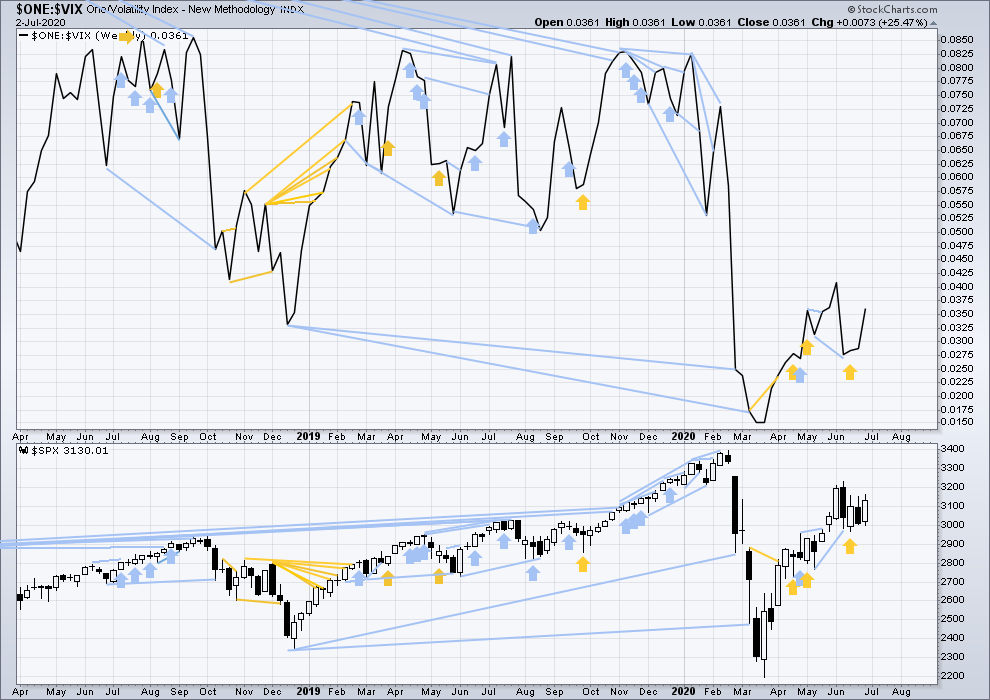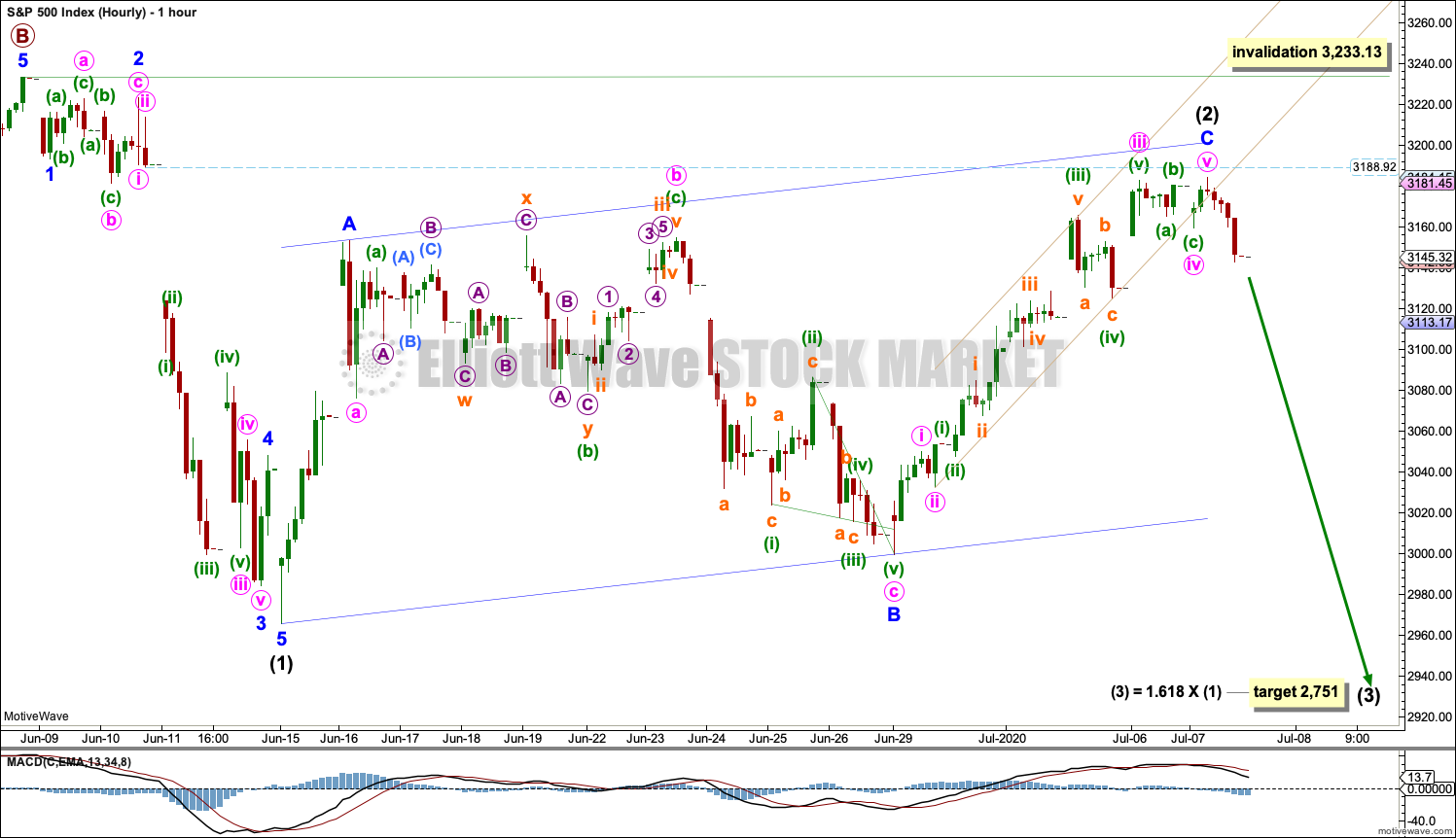S&P 500: Elliott Wave and Technical Analysis | Charts – July 7, 2020
A short-term target for a little upwards movement was at 3,187. Price reached higher to 3,184.25, 2.85 points below the target, before turning to close lower.
Summary: This analysis still leans bearish in expecting a sustainable high may be in place on June 8th.
The main wave count has two final targets at 2,031 and 1,708. The daily alternate wave count has a target at 1,289 for a third wave down.
A new low below 2,954.86 would invalidate the third alternate wave count and provide confidence in downwards targets.
The third alternate wave count outlines a bullish scenario. However, weakness in volume and breadth does not support this wave count at this time as it sees a third wave upwards underway. Third waves should exhibit strength. A new high above 3,233.13 is still required for confidence in this wave count.
The biggest picture, Grand Super Cycle analysis, is here.
Last monthly charts are here. Video is here.
ELLIOTT WAVE COUNTS
MAIN WEEKLY CHART
This main Elliott wave count expects that the bull market beginning in March 2009 was cycle wave I of Super Cycle wave (V). The trend change in February 2020 may have been only at cycle degree. Cycle wave II may last from one to a few years.
Cycle wave II would most likely subdivide as a zigzag; thus far that looks like what is unfolding. Primary waves A and B may both be complete. A second target is calculated at primary degree.
Cycle wave II may not move beyond the start of cycle wave I below 666.79.
MAIN DAILY CHART
Draw the wide maroon trend channel carefully: draw the first trend line from the end of primary wave 1 at 2,093.55 (December 26, 2014), to the end of primary wave 3 at 2,940.91 (September 21, 2018), then place a parallel copy on the end of primary wave 2 at 1,810.10 (February 11, 2016). The channel was fully breached in March 2020 indicating a trend change from the multi-year bull trend to a new bear trend. Resistance at the lower edge has been overcome; price has closed above this trend line. During the next downwards wave this line may offer some support.
Cycle wave II may subdivide as any Elliott wave corrective structure except a triangle. It would most likely be a zigzag (zigzags subdivide 5-3-5). It may now be complete.
Draw a channel about cycle wave II using Elliott’s technique for a correction. Draw the first trend line from the start of primary wave A to the end of primary wave B, then place a parallel copy on the end of primary wave A. Primary wave C may find support about the lower edge of this channel.
Intermediate wave (1) within primary wave C may be complete. Intermediate wave (2) may have ended today. At the daily chart level, intermediate wave (1) looks like a five and intermediate wave (2) looks strongly like a three.
If intermediate wave (2) continues any higher, then it may not move beyond the start of intermediate wave (1) above 3,233.13.
A new target is calculated for intermediate wave (3).
Two targets are calculated now for primary wave C. If price approaches the first target and either the structure of primary wave C is incomplete or price keeps falling, then attention would turn to the second target.
HOURLY CHART
Intermediate wave (2) may be complete again as a single zigzag.
This hourly chart shows all of intermediate waves (1) and (2). Intermediate wave (1) on the hourly chart looks very much like a five, and intermediate wave (2) on the hourly chart looks very much like a three. If this is correct, then a five down should follow. This will be labelled intermediate wave (3).
A smaller channel is drawn about minor wave C. This channel is breached by downwards movement, which may be an early indication of a possible trend change.
If intermediate wave (2) continues any higher, then it may not move beyond the start of intermediate wave (1) above 3,233.13.
Intermediate wave (3) may only subdivide as a five wave impulse.
FIRST ALTERNATE DAILY CHART
This alternate daily chart follows the First Alternate Monthly chart.
By simply moving the degree of labelling in the bull market beginning March 2009 up one degree, it is possible that a Grand Super Cycle trend change occurred on February 19, 2020. The bull market from March 2009 to February 2020 may have been a complete fifth wave labelled Super Cycle wave (V).
A bear market at Grand Super Cycle degree may be expected to last at least a decade, possibly longer. Corrections for this market tend to be much quicker than bullish moves, and so a fair amount of flexibility is required in expectations for duration of the different degrees.
Grand Super Cycle II would most likely subdivide as a zigzag, although it may be any corrective structure except a triangle. It should begin with a five down at the weekly chart time frame, which would be incomplete.
The first wave down on the daily chart is labelled cycle wave I. If this degree of labelling is wrong, it may be too high; it may need to be moved down one degree.
Following cycle wave I, cycle wave II may be a complete zigzag. A target for cycle wave III is now calculated.
Intermediate wave (2) may not move beyond the start of intermediate wave (1) above 3,233.13.
FIRST ALTERNATE HOURLY CHART
Cycle wave II may be a complete single zigzag. Hourly wave counts for the main daily chart work in the same way for this alternate. The degree of labelling for this alternate is all one degree higher.
Intermediate wave (2) may have moved higher today.
THIRD ALTERNATE DAILY CHART
This alternate daily chart follows the third alternate monthly chart. It will be published daily because the structure of the current upwards wave is different and so the invalidation point is different. This alternate chart labels the subdivisions of the long bull market differently. The channel is a best fit.
The target for the end of this bull market is provisional. It would best be calculated at primary degree, but that cannot be done until all of primary waves 1 through to 4 are complete. At that stage, the target will be recalculated and will very likely change.
Cycle wave V must subdivide as a five wave motive structure, most likely an impulse. Primary wave 1 within cycle wave V may be nearing completion.
Within primary wave 1: intermediate waves (1) through to (3) may be complete and intermediate wave (4) may not move into intermediate wave (1) price territory below 2,954.86.
Use Elliott’s first technique to draw a channel about primary wave 1. Draw the first trend line from the ends of intermediate waves (1) to (3), then place a parallel copy on the end of intermediate wave (2). Intermediate wave (4) remains within the channel and may have found support about the lower edge.
When primary wave 1 may be a complete five wave structure, then primary wave 2 should then unfold as a multi-week pullback and may not move beyond the start of primary wave 1 below 2,191.86.
In the short term, invalidation of this wave count by a new low below 2,954.86 would add confidence to the first two wave counts.
This alternate wave count is bullish.
This alternate wave count expects that at this stage a third wave labelled minor wave 3 should be unfolding higher. Volume and breadth do not at this stage support this wave count, so it remains an alternate.
Cycle wave V may last from one to several years.
TECHNICAL ANALYSIS
WEEKLY CHART

Click chart to enlarge. Chart courtesy of StockCharts.com.
Now three long upper wicks in a row is increasingly bearish. On Balance Volume turns down from resistance. Volume is very light, but this was a short week. Overall, for the short term at least, this chart looks bearish.
DAILY CHART

Click chart to enlarge. Chart courtesy of StockCharts.com.
The breakaway gap of 24th February has its upper edge at 3,328.45. A bearish analysis remains reasonable while this gap remains open. If this gap is closed, then a more bullish analysis that would expect new all time highs would increase in probability.
90% and 80% days are used to indicate a shift in sentiment from bearish to bullish, and vice versa. A sentiment shift occurs when one 90% or two back to back 80% days in one direction are then followed within three to four sessions by one 90% or two back to back 80% days in the opposite direction. This has occurred only twice on this chart.
The first instance is a 90% down day on the 18th of March followed by a 90% up day four sessions later on the 24th of March. It was this technical evidence that was primarily used to identify a sustainable low on the 23rd of March.
The second instance was a 90% up day on the 5th of June then an 80% up day on the 8th of June followed three sessions later by a very strong 90% down day on the 11th of June. This indicates a good probability that the high on the 8th of June may be sustainable.
Price is range bound with resistance about 3,230 and support about 2,965 to 3,000. A breakout of this range is required for confidence in the next direction for price. Volume suggests a downwards breakout may be more likely than upwards.
Volume does not support upwards movement. Stochastics is now overbought. This upwards swing may end soon.
BREADTH – AD LINE
WEEKLY CHART

Click chart to enlarge. Chart courtesy of StockCharts.com. So that colour blind members are included, bearish signals will be noted with blue and bullish signals with yellow.
Breadth should be read as a leading indicator.
Bullish divergence noted five weeks ago remains.
Last week price and the AD line have both moved higher. There is no new divergence.
Large caps all time high: 3,393.52 on 19th February 2020.
Mid caps all time high: 2,109.43 on 20th February 2020.
Small caps all time high: 1,100.58 on 27th August 2018.
Last week only large caps have made a new short-term swing high above the prior swing high of the 16th of June. Small and mid caps have not. This rise last week was led by large caps, which is a feature of an aged bull market; this supports a bearish Elliott wave count.
DAILY CHART

Click chart to enlarge. Chart courtesy of StockCharts.com. So that colour blind members are included, bearish signals will be noted with blue and bullish signals with yellow.
Although the NYSE AD line has made new all time highs on the 8th of June 2020, Lowry’s OCO AD line did not. Bullish divergence may still support a bullish wave count.
The AD line has made a new swing low, but price has not. This divergence is bearish.
Both price and the AD line have moved lower today. There is no new divergence.
VOLATILITY – INVERTED VIX CHART
WEEKLY CHART

Click chart to enlarge. Chart courtesy of StockCharts.com. So that colour blind members are included, bearish signals will be noted with blue and bullish signals with yellow.
Inverted VIX remains well below all time highs. There remains over two years of strong bearish divergence between price and inverted VIX.
Last week both price and inverted VIX have moved higher. There is no new short-term divergence.
DAILY CHART

Click chart to enlarge. Chart courtesy of StockCharts.com. So that colour blind members are included, bearish signals will be noted with blue and bullish signals with yellow.
VIX has made a new swing low below the prior swing low of March 13th / 14th, but price has not. This divergence is bearish for the short to mid term and supports either the main or first alternate Elliott wave counts.
Both price and inverted VIX have moved lower today. There is no new divergence.
DOW THEORY
Dow Theory has confirmed a bear market with the following lows made on a closing basis:
DJIA: 21,712.53 – a close below this point has been made on the March 12, 2020.
DJT: 8,636.79 – a close below this point has been made on March 9, 2020.
Adding in the S&P and Nasdaq for an extended Dow Theory, a bear market has now been confirmed:
S&P500: 2,346.58 – a close below this point has now been made on March 20, 2020.
Nasdaq: 7,292.22 – a close below this point was made on the March 12, 2020.
At this time, to shift Dow Theory from viewing a bear market to confirmation of a new bull market would require new highs made on a closing basis:
DJIA – 29,568.57
DJT – 11,623.58
Adding in the S&P and Nasdaq for an extended Dow Theory:
S&P500 – 3,393.52
Nasdaq – 9,838.37 – closed above on June 8, 2020.
Published @ 07:35 p.m. ET
—
Careful risk management protects your trading account(s).
Follow my two Golden Rules:
1. Always trade with stops.
2. Risk only 1-5% of equity on any one trade.
—
New updates to this analysis are in bold.






